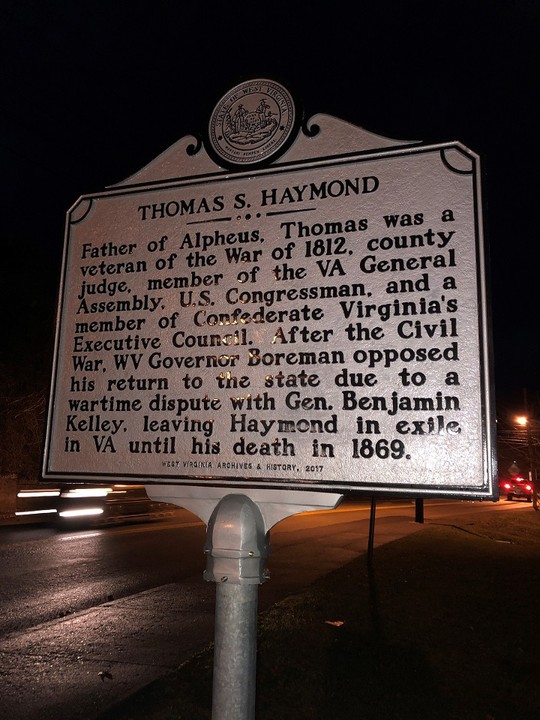Thomas S. Haymond Highway Historical Marker
Introduction
Text-to-speech Audio
Images
Thomas S. Haymond Highway Historical Marker

Backstory and Context
Text-to-speech Audio
Thomas Sherwood Haymond was born to an esteemed and prosperous family of English origin on January 15, 1794 near Fairmont, Virginia (now West Virginia). His paternal grandfather, Major William Haymond (1740-1821), served with Generals Braddock and Forbes during the French and Indian War. His father, William Calder Haymond (1771-1848), fought Native Americans along the Monongalia frontier. His mother, Cynthia (Carroll) Haymond, was a relative of Charles Carroll, a signer of the Declaration of Independence.
As a young man, Haymond attended private schools before enrolling at the College of William and Mary in Williamsburg, Virginia. During the War of 1812, he continued the family military tradition by volunteering to fight for his country, serving as a private. Following his time in the military, Haymond read law and gained admission to the bar in 1815. Shortly thereafter, he began practicing law in Morgantown. In 1822, Haymond married Harriet Franklin (1801-1857). The marriage produced many children, including Alpheus F. Haymond (1823-1893), who not only followed in his father’s footsteps by attending William and Mary and practicing law, but also represented Marion County in the Virginia House of Delegates and served as a justice on the West Virginia Supreme Court of Appeals.
In 1842, Haymond became president of the county court of newly-formed Marion County. Several years later, he was elected to the U.S. House of Representatives to fill the vacancy created by the death of Alexander Newman. A member of the Whig Party, Haymond served from November 1849 to March 1851. Most notably, during his time in the House, he broke with many of his colleagues from Virginia when, in May 1850, he spoke in favor of California’s admission to the Union as a free state.
Haymond’s support for a soon-to-be free state’s admission to the Union came despite the fact that he was a slaveholder. In 1830, census returns indicate that he owned seven enslaved individuals. By 1850, Haymond owned four. This reduction in the number of enslaved individuals that he owned was not due to declining personal fortune. In fact, Haymond’s wealth increased over the course of the late antebellum era. In 1850, he held $15,000 in real estate. By 1860, he doubled that and owned an additional $10,00 in personal estate.
When Virginia voted to secede from the Union in April 1861, Haymond followed the course of his native state. A few days later, delegates to the convention created an advisory council to aid the governor with preparations for war. Governor John Letcher appointed Haymond to the council, which, among other things, recommended that Robert E. Lee lead the state’s forces. Soon after, Haymond secured a commission as a colonel. He would serve as an officer in the Confederate Army for the entirety of the war. On April 5, 1869, Haymond died in Richmond, Virginia. His remains were buried in Palatine Cemetery, which is now part of Maple Grove Cemetery, in Fairmont.
In 2017, as part of its Civil War sesquicentennial project, the West Virginia Highway Historical Marker Program of the West Virginia Archives and History erected a marker dedicated to Thomas S. Haymond. It stands at the intersection of U.S. 19 and Maple Avenue in Fairmont, Marion County.
Sources
1830 United States Federal Census, Eastern District, Monongalia, Virginia.
1850 United States Federal Census, Population Schedule, Eastern District, Marion, Virginia.
1850 United States Federal Census, Slave Schedules, Eastern District, Marion, Virginia.
1860 United States Federal Census, Population Schedule, District 3: Marion, Virginia.
"A Guide to the Virginia Convention (1861: Richmond), Records, 1861-1961." Library of Virginia. Web. 16 September 2020 <http://ead.lib.virginia.edu/vivaxtf/view?docId=lva/vi00956.xml>.
Atkinson, George Wesley and Alvaro Franklin Gibbens. Prominent Men of West Virginia. Wheeling, WV: W.L. Callin, 1890.
Butcher, Bernard Lee. and James Morton Callahan. Genealogical and Personal History of the Upper Monongahela Valley, West Virginia. Vol. 2. New York: Lewis Historical Publishing, 1912.
Cole, J.R and Oren F. Morton. A History of Preston County, West Virginia. Vol. 2. Kingwood, WV: The Journal Publishing Company, 1914.
"Haymond, Thomas Sherwood." Biographical Directory of the United States Congress, 1774-Present. United States Congress. Web. 16 September 2020 <https://bioguideretro.congress.gov/Home/MemberDetails?memIndex=H000395>.
http://www.wvculture.org/history/markers/sesqui/alpheusfhaymond.html
